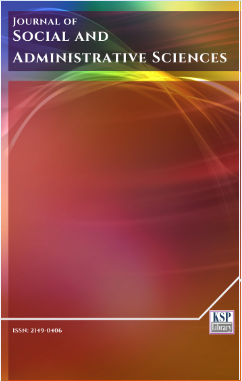Sukuk: Literature Review
Abstract
Abstract. At the heart of a global financial crisis triggered since 2008, Islamic finance has been seen as an alternative less affected by the global crisis to cover the financing and investment needs and bringing a new vision that involves sharing of losses and gains and thus prohibit the notion of the interest rate. With the emergence of the concept of Islamic finance a new market has emerged known as sukuk market where its last ones play the role of bonds. These financial instruments have been able, like conventional bonds, to constitute a reliable investment alternative for both companies and governments that want to conduct their business within a framework that respects the precepts of the Sharia. The purpose of this article is to understand the concept and the mechanism of these obligations and to present a review of the literature on sukuks.
Keywords. Sukuk, Islamic Finance, Bonds, Financial Instruments.
JEL. A10, H12.
References
Abdel-Khaleq, A., Richardson, C.F. (2007). New horizons for Islamic securities: emerging trends in sukuk offerings, Chicago Journal of International Law, 7(2), 409-425.
Adam, N.J. (2006). The evolution of sukuk, Establishing Singapore as an Islamic Financial Hub, Sukuk Masterclass, February 22–23. [Retrieved from].
Afsher, T.A. (2013). Compare and contrast Sukuk (Islamic bonds) with conventional bonds, are they compatible?, The Journal of Global Business Management, 9(1), 44-52.
Al-Khawarizmi, G. (2012). Les Sukuk: Une Nouvelle Alternative de Financement Pour le Maroc,. Al- Khawarizmi-Group, [Retrieved from].
Ariff, M., & Safari, M. (2012). Are sukuk securities the same as conventional bonds?, Afro Eurasian Studies, 1(1), 101-125.
Bourkhis, K., & Nabi, M.S. (2013). Islamic and conventional banks' soundness during the 2007–2008 financial crisis, Review of Financial Economics, 22(2), 68-77. doi. 10.1016/j.rfe.2013.01.001
Çakır, S., & Raei F. (2007). Sukuk vs. Eurobonds: Is There a Difference in Value-at-Risk? International Monetary Fund, Working Paper, No.WP/07/237. [Retrieved from].
El-Mosaid, F., Boutti, R. (2014). Sukuk and bond performance in Malaysia, International Journal of Economics and Finance, 6(2), 226- 234. doi. 10.5539/ijef.v6n2p226
Fathurahman, H., & Fitriati, R. (2013). Comparative analysis of return on sukuk and conventional bonds, American Journal of Economics, 3(3), 159-163. doi. 10.5923/j.economics.20130303.05
Godlewski, C.J., Turk-Ariss, R., Weill, L. (2013). Sukuk vs. conventional bonds: A stock market perspective, 745-761. doi. 10.1016/j.jce.2013.02.006
Godlewski, C.J. Turk-Arsis, R., & Weill, L. (2011). Do markets perceive Sukuk and conventional bonds as different financing instruments?, BOFIT Discussion Papers, No.2/2011. [Retrieved from].
Hardy, N. (2008). Finance islamique, Techniques et Enjeux, Paris: Banque.
Hassan, K.A. (2013). Comparison between Sukuk and conventional bonds: Value at risk approach, Unşversity Westminster Working Paper, [Retrieved from].
Hassoune, A. (2009). Cartographie de la finance islamique, Conférence sur la Finance Islamique, Paris, Bercy, Novembre, 3.
Najeeb, S.F., Bacha, O., & Masih, M. (2014). Does a held-to-maturity strategy impede effective portfolio diversification for Islamic bond (sukuk) portfolios? A multi-scale continuous wavelet correlation analysis, MPRA Working Paper, No.56956. [Retrieved from].
Naughton, S.A.J., & Tahir, M.A. (1988). Islamic banking and financial development, Journal of Islamic Banking and Finance, 5(2), 521-538.
Observateur De l’OCDE. (2009). Finance Islamique: Un placement d’avenir, No.272, Raynal.
Paltrinieri, A., Dreassi, A., Miani, S., Sclip, A. (2015). In search of zero beta assets: Evidence from the sukuk market, ICIBF, 2015, Conference Paper, Zurih.
Peillex, J., & Ureche-Rangau, L. (2012). Création d’un indice boursier Islamique sur la place financière de Paris: Méthodologie et performance, Revue d’économie Financière, (107), 289.
Rafique, M. (2008). Islamic finance can solve global crisis, Says Scholar. Arab News. [Retrieved from].
Ramasmy, R. (2011). Relative risk of Islamic sukuk over government and conventional bonds, Global Journal of Management and Business Research, 11(6), 5-12.
Rusgianto, S., & Ahmad, N. (2013). Volatility behavior of sukuk market: An emprical analyeis of the Dow Jones Ctigroup sukuk index, Middle East Journal of Scientific Research, 13(1), 93-97. doi. 10.5829/idosi.mejsr.2013.13.1887
Vishwanath, S.R., & Azmi, S. (2009). An overview of Islamic sukuk bonds, The Journal of Strutured Finance, 14(4), 58-67. doi. 10.3905/JSF.2009.14.4.058
DOI: http://dx.doi.org/10.1453/jsas.v4i1.1241
Refbacks
- There are currently no refbacks.
....................................................................................................................................................................................................................................................................................................................................... Journal of Social and Administrative Sciences - J. Adm. Soc. Sci. - JSAS - www.kspjournals.org
ISSN: 2149-0406
Editor: editor-jsas@kspjournals.org Secretarial: secretarial@kspjournals.org Istanbul - Turkey.
Copyright © KSP Library




